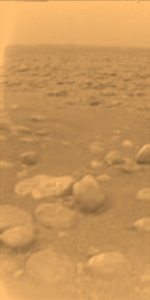Science highlights from Huygens:
#8. Dry river beds and lakes
| Huygens's descent to Titan's surface. Credit: ESA/NASA/JPL/University of Arizona. (Click here for further details and larger versions of this video.) |
The DISR took several hundred visible-light images with its three cameras during its 2 hour 27 minute descent, including several sets of stereo image pairs which enabled scientists to construct digital terrain models.
The cameras revealed a plateau with a large number of dark channels cut into it, forming drainage networks which bore many similarities to those on Earth. The narrow channels converged into broad rivers, which drained into a broad, dark, lowland region. The ravines cut by the rivers were approximately 100 m deep and their valley slopes were very steep, which suggested rapid erosion due to sudden, violent flows.
 |
| Titan's surface viewed by DISR. Credit: ESA/NASA/JPL/ University of Arizona |
No evidence of surface liquid was found at the time of the landing. However, it seems likely that, from time to time, the entire dark region is innundated by floods of liquid methane and ethane. If the darker region is a dry lakebed, it is too large to have been caused by the creeks and channels visible in the images. It may have been created by other larger river systems or some large-scale catastrophic event, which predates deposition by the rivers seen in the images.
Brighter regions north of the landing site displayed two different drainage patterns: (1) bright highlands with rough topography and deeply incised branching (dendritic) drainage networks with dark-floored valleys that indicated erosion by methane rainfall; and (2) short, stubby channels that followed linear fault patterns, forming canyon-like features suggestive of spring sapping by liquid methane.
The topographic data showed that the bright highland terrains are extremely rugged, often with slopes of up to 30 degrees. These drain into relatively flat, dark lowland terrains. The dark material that covers the plains may have been carried along by the flows and could be made up of photochemical deposits rained down from above.
The landing site itself resembled a dried-up riverbed. Rounded cobbles, 10 cm to 15 cm in diameter and probably made of hydrocarbons and water ice, rested on a darker granular surface.





